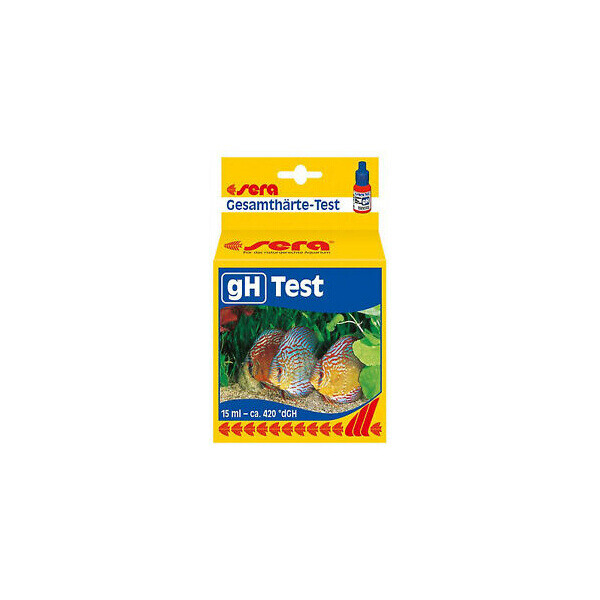Sera GH-Test-15mlVolume: 15ml
sera gH-Test
FRESH WATER , PONDWATER TESTINGCARE Makes it easy to monitor the total hardness
In case of too low GH values we recommend sera mineral salt. High total hardness levels can be lowered by mixing in R/O water.
For creating soft water we recommend adding sera blackwater aquatan or filtering through sera super peat.
Shake reagent bottle well before using! Do not allow testedwater to contact aquarium or pond water!
1. Rinse the measurement vial several times with the water to be tested, then fill tothe 5 ml mark. Dry the vial on the outside.2. Add reagent drop by drop. Shake vial gently after every drop, until the colorchanges from red via brown to green.3. The number of drops used from the reagent represents the existing total hardness(in °dGH). E.g., 5 drops = 5°dGH.4. Cleaning: Clean the vial thoroughly with tap water before and after eachtest.Close reagent bottle immediately after use. Store at room temperature and away fromlight. Keep locked up and out of the reach of children. For testing ornamentalfish aquariums and pond water only.
US Information for useMost ornamental fish originate from countries where the soil is poor in minerals.However, it is exactly the opposite in many other areas around the world. Rain waterdissolves calcium and magnesium from the soil and consequently creates hard water.With the sera gH-Test, you can quickly determine the exact total hardness. Lookingat the natural conditions helps selecting the optimal fish stock for a communityaquarium, and is a precondition for successful breeding. High total hardness levelscan be lowered by mixing in R/O water. A combination of sera aquatan and serablackwater aquatan or filtering through sera super peat will create soft water, asrequired for most South American fish (e.g. from the Amazon basin).
sera gH-Test
FRESH WATER , PONDWATER TESTINGCARE Makes it easy to monitor the total hardness
In case of too low GH values we recommend sera mineral salt. High total hardness levels can be lowered by mixing in R/O water.
For creating soft water we recommend adding sera blackwater aquatan or filtering through sera super peat.
Shake reagent bottle well before using! Do not allow testedwater to contact aquarium or pond water!
1. Rinse the measurement vial several times with the water to be tested, then fill tothe 5 ml mark. Dry the vial on the outside.2. Add reagent drop by drop. Shake vial gently after every drop, until the colorchanges from red via brown to green.3. The number of drops used from the reagent represents the existing total hardness(in °dGH). E.g., 5 drops = 5°dGH.4. Cleaning: Clean the vial thoroughly with tap water before and after eachtest.Close reagent bottle immediately after use. Store at room temperature and away fromlight. Keep locked up and out of the reach of children. For testing ornamentalfish aquariums and pond water only.
US Information for useMost ornamental fish originate from countries where the soil is poor in minerals.However, it is exactly the opposite in many other areas around the world. Rain waterdissolves calcium and magnesium from the soil and consequently creates hard water.With the sera gH-Test, you can quickly determine the exact total hardness. Lookingat the natural conditions helps selecting the optimal fish stock for a communityaquarium, and is a precondition for successful breeding. High total hardness levelscan be lowered by mixing in R/O water. A combination of sera aquatan and serablackwater aquatan or filtering through sera super peat will create soft water, asrequired for most South American fish (e.g. from the Amazon basin).
Barcode:
4001942041102
sera gH-Test
FRESH WATER , PONDWATER TESTINGCARE Makes it easy to monitor the total hardness
In case of too low GH values we recommend sera mineral salt. High total hardness levels can be lowered by mixing in R/O water.
For creating soft water we recommend adding sera blackwater aquatan or filtering through sera super peat.
Shake reagent bottle well before using! Do not allow testedwater to contact aquarium or pond water!
1. Rinse the measurement vial several times with the water to be tested, then fill tothe 5 ml mark. Dry the vial on the outside.2. Add reagent drop by drop. Shake vial gently after every drop, until the colorchanges from red via brown to green.3. The number of drops used from the reagent represents the existing total hardness(in °dGH). E.g., 5 drops = 5°dGH.4. Cleaning: Clean the vial thoroughly with tap water before and after eachtest.Close reagent bottle immediately after use. Store at room temperature and away fromlight. Keep locked up and out of the reach of children. For testing ornamentalfish aquariums and pond water only.
US Information for useMost ornamental fish originate from countries where the soil is poor in minerals.However, it is exactly the opposite in many other areas around the world. Rain waterdissolves calcium and magnesium from the soil and consequently creates hard water.With the sera gH-Test, you can quickly determine the exact total hardness. Lookingat the natural conditions helps selecting the optimal fish stock for a communityaquarium, and is a precondition for successful breeding. High total hardness levelscan be lowered by mixing in R/O water. A combination of sera aquatan and serablackwater aquatan or filtering through sera super peat will create soft water, asrequired for most South American fish (e.g. from the Amazon basin).
sera gH-Test
FRESH WATER , PONDWATER TESTINGCARE Makes it easy to monitor the total hardness
In case of too low GH values we recommend sera mineral salt. High total hardness levels can be lowered by mixing in R/O water.
For creating soft water we recommend adding sera blackwater aquatan or filtering through sera super peat.
Shake reagent bottle well before using! Do not allow testedwater to contact aquarium or pond water!
1. Rinse the measurement vial several times with the water to be tested, then fill tothe 5 ml mark. Dry the vial on the outside.2. Add reagent drop by drop. Shake vial gently after every drop, until the colorchanges from red via brown to green.3. The number of drops used from the reagent represents the existing total hardness(in °dGH). E.g., 5 drops = 5°dGH.4. Cleaning: Clean the vial thoroughly with tap water before and after eachtest.Close reagent bottle immediately after use. Store at room temperature and away fromlight. Keep locked up and out of the reach of children. For testing ornamentalfish aquariums and pond water only.
US Information for useMost ornamental fish originate from countries where the soil is poor in minerals.However, it is exactly the opposite in many other areas around the world. Rain waterdissolves calcium and magnesium from the soil and consequently creates hard water.With the sera gH-Test, you can quickly determine the exact total hardness. Lookingat the natural conditions helps selecting the optimal fish stock for a communityaquarium, and is a precondition for successful breeding. High total hardness levelscan be lowered by mixing in R/O water. A combination of sera aquatan and serablackwater aquatan or filtering through sera super peat will create soft water, asrequired for most South American fish (e.g. from the Amazon basin).
For Any Enquiries
+971 4 229 3919
+971 50 536 9874
Our Delivery Promise
- 1-Hour Delivery in Dubai* (Conditions apply)
- Same Day/ 24-Hour Delivery in all over UAE
For Bulk Orders
Call Our Dedicated Line
+971 585859871







